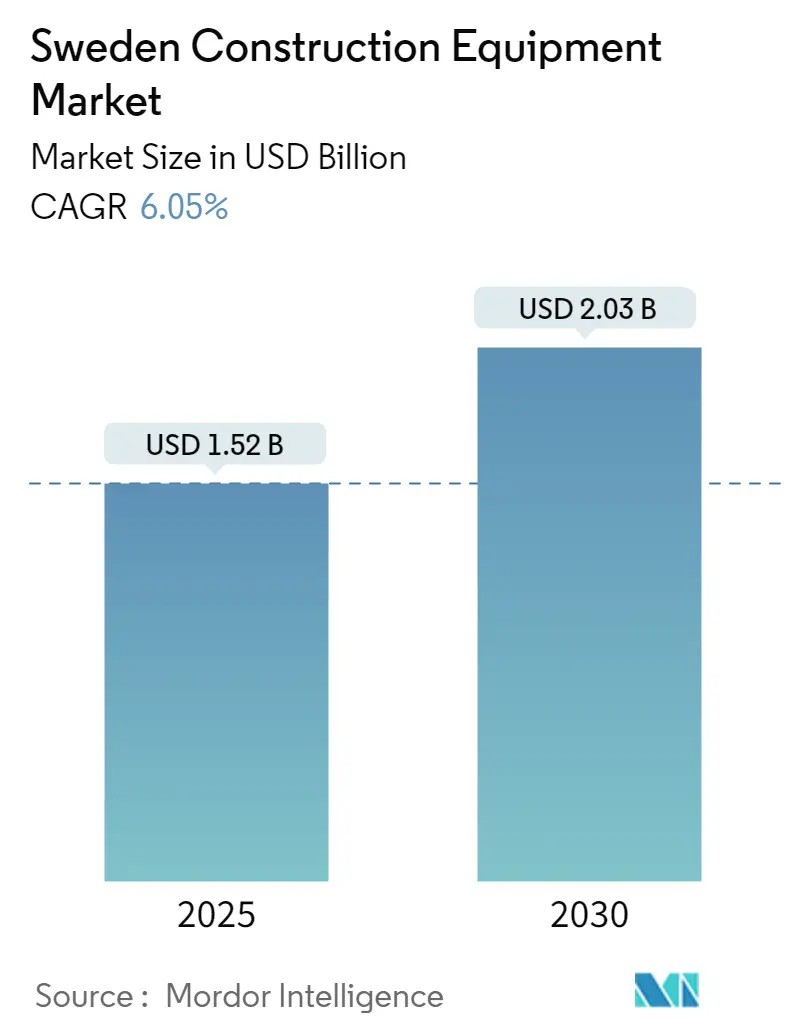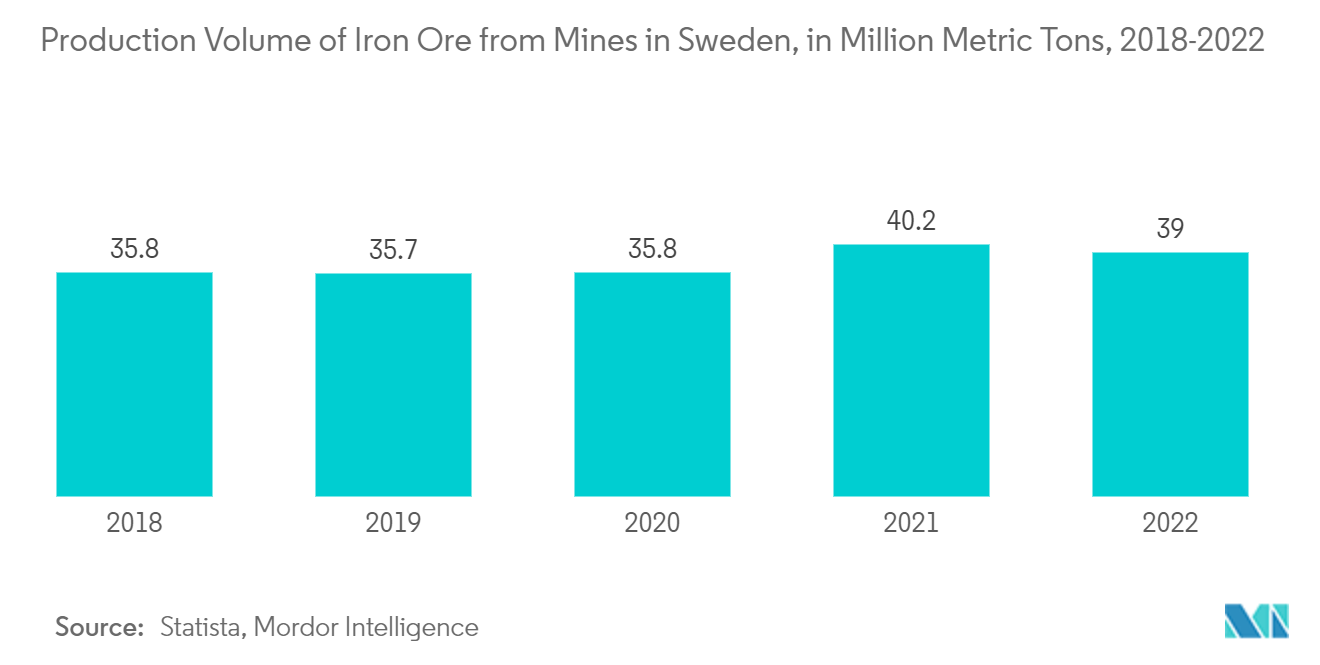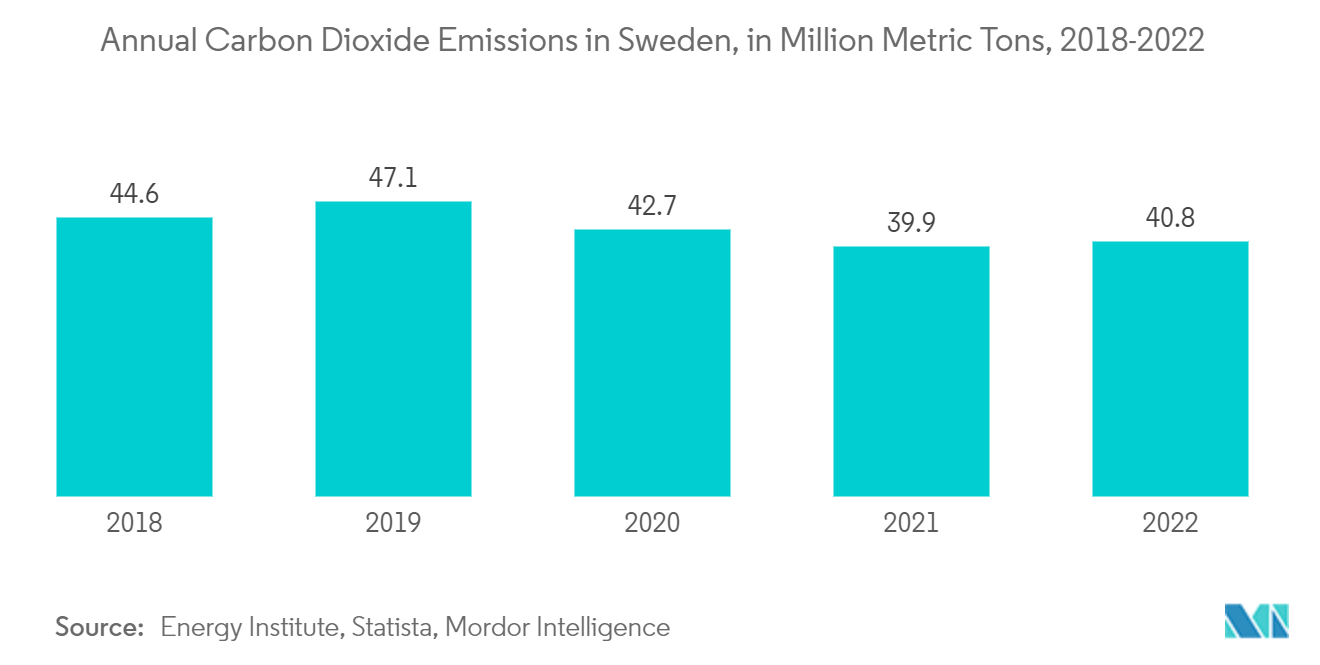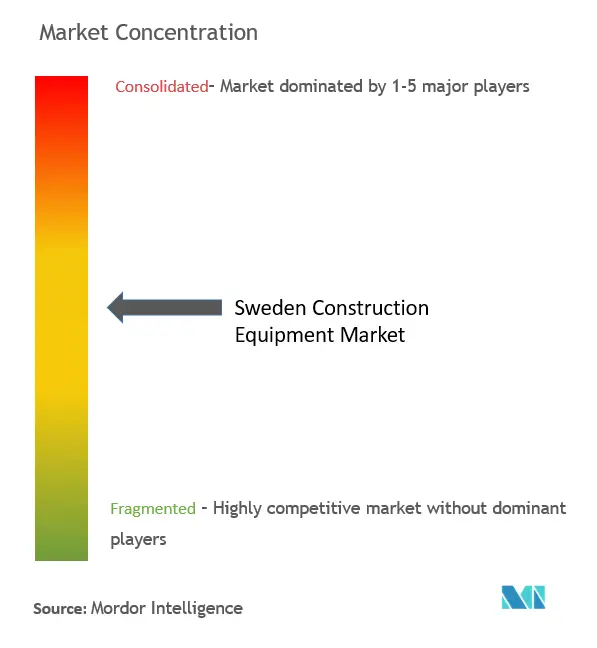Sweden Construction Equipment Market Size and Share

Sweden Construction Equipment Market Analysis by Mordor Intelligence
The Sweden Construction Equipment Market size is estimated at USD 1.52 billion in 2025, and is expected to reach USD 2.03 billion by 2030, at a CAGR of 6.05% during the forecast period (2025-2030).
Increasing government spending on infrastructural development, rising investments in the construction and mining sector, and developments in road transportation infrastructure owing to the surge in population and urbanization serve as the major determinants for the growth of the construction market in Sweden, which, in turn, positively contributes to the surging demand for construction equipment across the country.
Sweden boasts of one of the highest urbanization rates in the European region, with 88% of its overall population residing in urban areas as of 2022. The high urbanization rate leads to consumers availing various private and public transportation mediums for their commutes, which leads to higher congestion in these cities. Therefore, road infrastructure development has become a major focus area for the Swedish government. Coupled with that, developments in cross-border road connectivity serve as another deterministic area for enhancing the trade ecosystem of a nation. Hence, with the government's increasing focus on developing its road infrastructural network, there exists a massive demand for construction equipment in the country.
For instance, the Swedish government is highly focused on investing large sums in the Stockholm Bypass project to develop a new motorway linking southern and northern Stockholm and create a new route for the European E4 highway past Stock. This project aims to manage the ever-increasing road congestion that accompanies the population growth in Stockholm, which is expected to reach 2.5 million by 2030.
One of the major challenges faced by the construction equipment industry in Sweden is the high cost of replacement and maintenance of the equipment, which becomes a financial burden for construction companies and equipment rental companies. Since these equipment products operate for a longer duration and need to sustain heavy loads at all times, there is constant wear and tear of the equipment, which needs frequent maintenance checks and, in extreme cases, complete replacement of the product.
Thus, construction companies and equipment rental companies owning these machinery need to spend hefty sums to make sure that these equipment are operating efficiently at all times, which increases their cost of operation. Coupled with that, falling demand for housing in Sweden, owing to the increasing interest rate and high mortgage debt, is negatively impacting the housing sector development, which in turn deters the growth of the construction equipment market in the country.
The Swedish government follows old and rigid policies for controlling rent, which negatively impacts the building of new houses for rent due to the low-profit margin for the house owners and builders. Further, the central bank's strategy to increase interest rates is deterring consumers from taking further debts for constructing new houses, thereby affecting the construction equipment market in Sweden.
The government's pragmatic initiatives for infrastructural development across Sweden are anticipated to contribute to the surging demand for construction equipment in the coming years. For instance, in May 2023, the Swedish Transport Administration announced the construction of a permanent electric road, which is expected to lead to an expansion of a further 3,000 km of electric roads in the country by 2035. The administration announced that it had identified the E20 highway as the ideal location for this pioneering endeavor, a 13-mile (21 km) stretch extending from Hallsberg to Örebro between Stockholm and Gothenburg, which is expected to be accessible to the public from 2025-2026. With increasing investment to enhance the infrastructural capability of Sweden, there will exist a massive demand for construction equipment during the forecast period.
Sweden Construction Equipment Market Trends and Insights
Increasing Government Spending on Construction, Infrastructure, and Mining Sector
- Increasing investment in the country's real estate, commercial, and construction sectors, among others, and the growing mining sector is further aiding the demand for advanced construction machinery across Sweden. Various development projects, such as the National Transport Develop Plan, assist in expanding the construction market across the country, thus, in turn, positively impacting the demand for construction equipment. For instance,
- In January 2023, LKAB, a state-owned Swedish mining company, announced that it had found Europe's largest known deposit of coveted rare earth metals, critical to many green technologies, including electric vehicles, in a far northern part of the country within the Arctic Circle. As the Swedish government formulates a plan to initiate the extraction of these rare raw materials, the mining sector of the country will witness a rapid expansion in the coming years, which in turn will foster the growth of the construction equipment market.
- In June 2022, the Swedish government announced a new national transport infrastructure plan that will witness a record sum of SEK 881 billion (USD 86.6 billion) being spent during 2022-2027. Out of the overall investment envisaged, SEK 165 billion (USD 14.87) will be allocated for the operational and maintenance of the national railway network, and a total of SEK 437 billion (USD 39.38 billion) will be invested to develop the Swedish transport system across all modes.
- Coupled with that, rising investment in enhancing the transportation infrastructure of the nation is expected to boost the construction equipment market in Sweden in the coming years. Various private companies operating across Sweden, such as Electreon, are actively focusing on assisting the government in their strategy for the electrification of road transportation infrastructure across Sweden. For instance,
- In January 2023, Electreon, an Israeli-based startup, announced that it had raised NIS 40 million (USD 11.8 million) to bid on a tender for the construction of the first 42-kilometer (26-mile) long electric road in Sweden. The purpose of the financing was to enable the company to compete in the largest electrification tender in Europe.
- With the government's consistent effort to build a decarbonized public transport infrastructure, along with the support provided by the private construction companies to assist the government's pragmatic plans, the construction equipment market is anticipated to record surging growth during the forecast period.

Electric Drive Segment of the Market to Gain Traction during the Forecast Period
- The extensive focus of the Swedish government to achieve a carbon-neutral economy is aiding the rapid transformation in various sectors in adopting a new energy ecosystem. With the aggressive strategy adopted by the government of Sweden to achieve a reduction in carbon emissions, there will exist a greater demand for advanced products used in various sectors, which helps in the reduction of carbon content in the environment. For instance,
- The Swedish government has formulated a long-term strategy to achieve no net emission of greenhouse gases into the atmosphere by 2045. Further, the government has also announced that they are active measures to ensure that emissions are lowered by 63% by 2030 compared to 1990 levels. Sweden has also imposed a carbon tax to promote the utilization of new energy. As of June 2023, the carbon tax stood at Euro 122 (USD 130) per tonne of fossil carbon dioxide emitted.
- Total renewable energy capacity in Sweden touched 38,044 megawatts in 2022, expanding at a CAGR of 6.9% between 2018 and 2022. Therefore, with the increasing focus on promoting the utilization of new energy sources, Sweden is recording falling CO2 emissions in the country, which fell to 40.8 million metric tons in 2022, compared to 47.1 million metric tons in 2019.
- With the shifting focus towards adopting a new energy ecosystem, various companies operating in different industries are actively promoting the use of products and equipment to help in air pollution reduction. Construction equipment companies operating in space are investing hefty sums in developing new products that are operated via an electric drive type, which is expected to record surging growth in the coming years. For instance,
- In January 2023, Volvo Construction Equipment, a Sweden-based construction equipment manufacturer, announced the introduction of the DD25 Electric asphalt compactor at ConExpo 2023, making it the first electric product to be developed in the asphalt segment. The company further announced that this specific model will be available to consumers from Q1 2024.
- Further, in January 2023, Volvo CE announced an investment of SEK 65 million (USD 6.3 million) into the production of electric wheel loaders from its plant in Arvika, Sweden, As part of its ambition towards industry transformation through sustainable solutions.
- Moreover, electric construction equipment products being developed by international manufacturers are being made available to Swedish customers via their dealership network operating in the country. With the increasing focus on decarbonization, there will exist a greater demand for electric drive-type equipment in the coming years as more and more construction and rental companies include these products in their fleet, thereby contributing to the surging growth of the electric drive-type segment of the market during the forecast period.

Competitive Landscape
The market is fragmented and competitive, with the presence of various international construction equipment companies operating across Sweden either through a dealership network or via their manufacturing facility. Some of the major players include Caterpillar, Komatsu, Liebherr, Volvo Construction Equipment, Kubota, Kobelco, JCB, Hitachi Construction Machinery, Takeuchi, and Hyundai Construction Equipment, among others. These players compete based on various parameters such as equipment quality, price, dealership network, geographical coverage, aftersales services, product diversification, and value-added services such as equipment as a service (EaaS), among others.
Various companies operating in the ecosystem are highly focusing on investing hefty sums in R&D activity to diversify their construction equipment product portfolio across Sweden to cater to the increasing demand of the customers. For instance,
In July 2023, Volvo Construction Equipment, a construction equipment company based out of Sweden, announced the launch of a new Compact Business unit to integrate the lucrative opportunity that the compact equipment market provides.
In August 2022, Volvo Group announced the initiation of the process to establish a large-scale production plant for battery cells in Sweden, which will be designed specifically for commercial vehicle applications, supporting the global roll-out of construction equipment and electric drivelines for different applications.
In June 2022, Liebherr, a construction equipment manufacturer, exhibited numerous earthmoving and material handling machines for a wide range of applications at the Svenska Maskinmässan fair held in Stockholm, Sweden. With the L 508 Compact, the L 556 XPower, the L 586 XPower, and the L 509 Tele, Liebherr exhibited four of its wheel loader models to attract customers in Sweden. Further, the company also exhibited its Generation 8 crawlers and compact wheeled excavators at the fair.
The market is expected to witness the launch of various advanced construction equipment products to cater to the growing needs of customers, which will assist the companies in gaining a competitive edge in the market.
Sweden Construction Equipment Industry Leaders
Caterpillar
Komatsu
Liebherr
Volvo Construction Equipment
Kubota
- *Disclaimer: Major Players sorted in no particular order

Recent Industry Developments
- August 2023: Volvo Construction Equipment, a Sweden-based manufacturer of construction equipment, unveiled an updated range of Volvo Service Contracts as a pivotal part of its post-sales division. These contracts are a rebranding of the previous Customer Services Agreements and offer valuable solutions for customers in managing the repair and maintenance needs of their Volvo machinery. The newly introduced service agreements consist of three tiers: the Blue Contract, which covers preventive maintenance and servicing, and the Gold Contract, which encompasses comprehensive machine repairs and preventive maintenance to maximize equipment uptime.
- June 2023: Volvo CE made a significant announcement regarding the relocation of its global headquarters. The company will be moving from its current base in Gothenburg, Sweden, to Eskilstuna, Sweden. This strategic move is part of an ongoing initiative aimed at fostering collaboration and innovation by connecting with local educational institutions, social organizations, and business networks. Notably, this includes a strong partnership with Malardalen University, a collaboration that has proven instrumental in nurturing engineering talent and catalyzing innovative solutions that will ultimately benefit Volvo CE.
- February 2023: Hitachi Construction Machinery, a Japan-based construction equipment company, unveiled plans to implement an 8% price increase for its equipment, effective from April 2023. This price adjustment extends to global customers, including those in Sweden. Customers purchasing equipment through local dealerships in Sweden can also anticipate an 8% price hike compared to the 2022 pricing.
- November 2022: Volvo Construction Equipment announced a groundbreaking partnership with Skanska, a prominent Stockholm-based construction firm, a Volvo CE dealership, and other key stakeholders. This collaboration is dedicated to supporting the urban development project within Stockholm City's meatpacking district. Under the terms of this partnership, Volvo CE will supply the EC230 Electric, a cutting-edge 23-ton battery electric excavator, to contribute to the construction of 3,000 homes and 14,000 workplaces in the neighborhood. This initiative is underpinned by a commitment to minimizing greenhouse gas emissions, reflecting Volvo CE's dedication to sustainable urban development.
Sweden Construction Equipment Market Report Scope
Construction equipment refers to machines or devices drawn as trailers designed and used for construction, tree trimming, and allied construction activities. The construction equipment market consists of a wide range of companies involved in the designing, manufacturing, and selling of construction equipment, such as cranes, excavators, backhoe loaders, and motor graders, among others, to its end users.
The Sweden construction equipment market is segmented by equipment type and drive type. By equipment type, the market is segmented into earthmoving equipment (excavators, backhoe loaders, motor graders, and other earthmoving equipment), road construction equipment (road rollers and asphalt pavers), material handling equipment (cranes, forklift & telescopic handlers, and other material handling equipment), and other construction equipment (concrete pump trucks, dumpers, tippers, etc.). By drive type, the market is segmented into hydraulic and electric/hybrid.
The report offers market size and forecast value (USD) for all the above segments.
| Earthmoving Equipment | Excavators |
| Backhoe Loaders | |
| Motor Graders | |
| Other Earthmoving Equipment (Bull Dozers, etc.) | |
| Road Construction Equipment | Road Rollers |
| Asphalt Pavers | |
| Material Handling Equipment | Cranes |
| Forklift & Telescopic Handlers | |
| Other Material Handling Equipment (Articulated Boom Lifts, etc.) | |
| Other Construction Equipment (Concrete Pump Trucks, Dumpers, Tippers, etc. ) |
| Hydraulic |
| Electric/Hybrid |
| By Equipment Type | Earthmoving Equipment | Excavators |
| Backhoe Loaders | ||
| Motor Graders | ||
| Other Earthmoving Equipment (Bull Dozers, etc.) | ||
| Road Construction Equipment | Road Rollers | |
| Asphalt Pavers | ||
| Material Handling Equipment | Cranes | |
| Forklift & Telescopic Handlers | ||
| Other Material Handling Equipment (Articulated Boom Lifts, etc.) | ||
| Other Construction Equipment (Concrete Pump Trucks, Dumpers, Tippers, etc. ) | ||
| By Drive Type | Hydraulic | |
| Electric/Hybrid | ||
Key Questions Answered in the Report
How big is the Sweden Construction Equipment Market?
The Sweden Construction Equipment Market size is expected to reach USD 1.52 billion in 2025 and grow at a CAGR of 6.05% to reach USD 2.03 billion by 2030.
What is the current Sweden Construction Equipment Market size?
In 2025, the Sweden Construction Equipment Market size is expected to reach USD 1.52 billion.
Who are the key players in Sweden Construction Equipment Market?
Caterpillar, Komatsu, Liebherr, Volvo Construction Equipment and Kubota are the major companies operating in the Sweden Construction Equipment Market.
What years does this Sweden Construction Equipment Market cover, and what was the market size in 2024?
In 2024, the Sweden Construction Equipment Market size was estimated at USD 1.43 billion. The report covers the Sweden Construction Equipment Market historical market size for years: 2019, 2020, 2021, 2022, 2023 and 2024. The report also forecasts the Sweden Construction Equipment Market size for years: 2025, 2026, 2027, 2028, 2029 and 2030.
Page last updated on:
Sweden Construction Equipment Market Report
Statistics for the 2025 Sweden Construction Equipment market share, size and revenue growth rate, created by Mordor Intelligence™ Industry Reports. Sweden Construction Equipment analysis includes a market forecast outlook for 2025 to 2030 and historical overview. Get a sample of this industry analysis as a free report PDF download.



